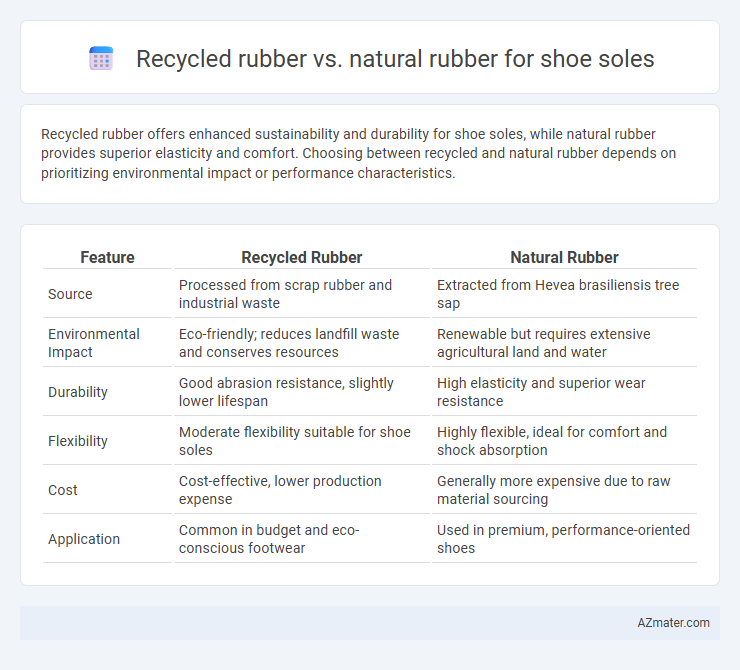Recycled rubber offers enhanced sustainability and durability for shoe soles, while natural rubber provides superior elasticity and comfort. Choosing between recycled and natural rubber depends on prioritizing environmental impact or performance characteristics.
Table of Comparison
| Feature | Recycled Rubber | Natural Rubber |
|---|---|---|
| Source | Processed from scrap rubber and industrial waste | Extracted from Hevea brasiliensis tree sap |
| Environmental Impact | Eco-friendly; reduces landfill waste and conserves resources | Renewable but requires extensive agricultural land and water |
| Durability | Good abrasion resistance, slightly lower lifespan | High elasticity and superior wear resistance |
| Flexibility | Moderate flexibility suitable for shoe soles | Highly flexible, ideal for comfort and shock absorption |
| Cost | Cost-effective, lower production expense | Generally more expensive due to raw material sourcing |
| Application | Common in budget and eco-conscious footwear | Used in premium, performance-oriented shoes |
Introduction to Rubber Materials for Shoe Soles
Recycled rubber and natural rubber serve distinct roles in shoe sole manufacturing, each offering unique material properties that influence durability, flexibility, and environmental impact. Natural rubber, derived from latex of rubber trees, provides excellent elasticity and resilience, making it ideal for high-performance athletic shoes. Recycled rubber, sourced from repurposed tires and industrial scraps, contributes sustainable benefits and cost efficiency but may vary in consistency and wear resistance compared to natural rubber.
What Is Recycled Rubber?
Recycled rubber is made from repurposed scrap tires and industrial rubber waste, processed into crumb or granulated form for manufacturing shoe soles. This sustainable material offers durability, flexibility, and environmental benefits by reducing landfill waste and conserving natural resources. Unlike natural rubber, which is harvested from rubber tree latex, recycled rubber provides a cost-effective and eco-friendly alternative for footwear production.
What Is Natural Rubber?
Natural rubber, derived from the latex sap of rubber trees (Hevea brasiliensis), offers exceptional elasticity, durability, and a high degree of flexibility ideal for shoe soles. Compared to recycled rubber, natural rubber provides superior traction and resilience, enhancing comfort and wear resistance in footwear applications. Its biodegradable properties also make it an eco-friendly choice, contributing to sustainable shoe manufacturing practices.
Durability: Recycled vs. Natural Rubber Soles
Recycled rubber shoe soles offer enhanced durability due to their resistance to abrasion, making them ideal for high-wear applications. Natural rubber soles provide excellent elasticity and flexibility but may wear down faster under heavy use or harsh conditions. Choosing recycled rubber increases longevity and sustainability, while natural rubber balances comfort with moderate durability.
Environmental Impact Comparison
Recycled rubber shoe soles significantly reduce landfill waste and lower carbon emissions compared to natural rubber, which requires extensive deforestation and water use during harvesting. The production of recycled rubber uses less energy and diminishes reliance on virgin materials, promoting circular economy principles. Natural rubber cultivation contributes to biodiversity loss and soil degradation, whereas recycled rubber supports sustainable resource management by repurposing existing materials.
Comfort and Performance Differences
Recycled rubber shoe soles offer enhanced durability and environmental benefits but may lack the natural elasticity and cushioning properties found in natural rubber, impacting long-term comfort. Natural rubber provides superior flexibility, shock absorption, and grip, improving overall shoe performance and wearer comfort during extended use. Performance-wise, natural rubber excels in responsiveness and traction under various conditions, while recycled rubber may sacrifice some of these qualities for sustainability advantages.
Cost Analysis: Recycled vs. Natural Rubber
Recycled rubber offers a significant cost advantage over natural rubber for shoe soles due to lower raw material expenses and reduced energy consumption during processing. Natural rubber prices fluctuate with global agricultural factors and supply chain variability, leading to higher and less predictable costs. Manufacturers often choose recycled rubber to optimize production budgets while maintaining sufficient durability and comfort in footwear applications.
Traction and Grip Evaluation
Recycled rubber shoe soles often offer enhanced traction and grip due to their higher abrasion resistance and denser composite structure compared to natural rubber. Natural rubber provides superior elasticity and flexibility, contributing to better surface conformity and slip resistance on wet surfaces. Evaluations reveal that while recycled rubber excels in durability and coarse terrain grip, natural rubber outperforms in dynamic traction and comfort on smooth or uneven indoor surfaces.
Aesthetic and Design Flexibility
Recycled rubber offers greater aesthetic versatility for shoe soles, allowing designers to incorporate a wide range of colors, textures, and patterns that appeal to contemporary fashion trends. Natural rubber provides superior elasticity and a smooth, uniform finish, which is favored for classic, high-end designs requiring refined detail. The choice between recycled and natural rubber significantly impacts design flexibility, with recycled rubber enabling innovative, bold styles while natural rubber emphasizes timeless elegance.
Which Rubber Sole Is Best for You?
Recycled rubber soles offer excellent durability and environmental benefits, making them ideal for eco-conscious consumers seeking long-lasting footwear. Natural rubber soles provide superior flexibility, comfort, and traction, which suit individuals prioritizing natural materials and high performance. Choosing the best rubber sole depends on your values, with recycled rubber excelling in sustainability and natural rubber delivering enhanced wearability and grip.

Infographic: Recycled rubber vs Natural rubber for Shoe sole
 azmater.com
azmater.com